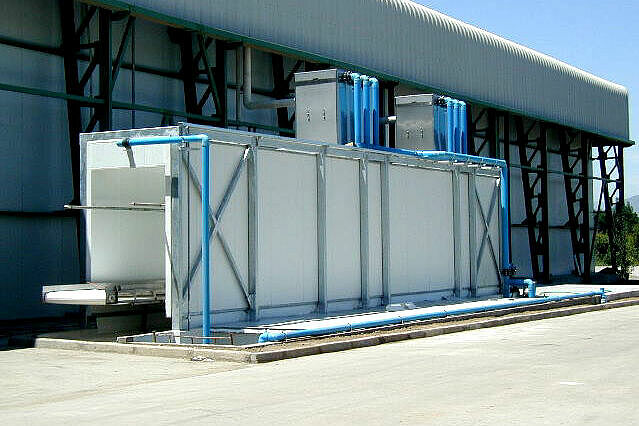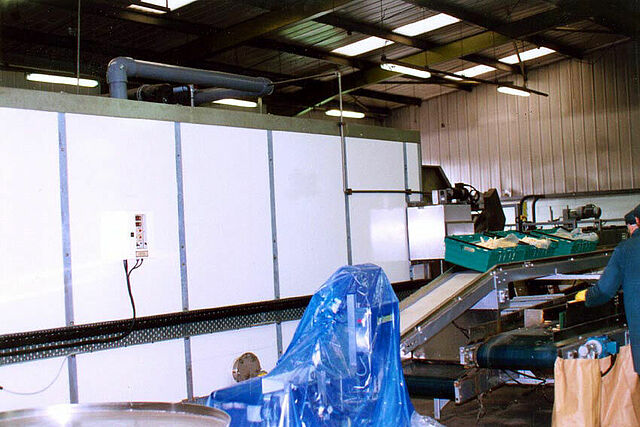

General Manager
Sven-Olaf Klüe has been working in the field of design, manufacture and applications of pillow plate heat exchangers worldwide for 27 years. For the past 15 years, he has focused specifically on the process-related applications of pillow plate heat exchangers in industrial applications.
Cooling fruit and vegetables
BUCO Falling Film Chiller in use for effective hydrocooling of fruit and vegetables
Our Falling Film Chillers as hydro coolers are an unbeatable alternative in the cooling of fruit and vegetables with a more effective and faster cooling of the product with lower energy consumption, as about 15 times faster than with air cooling. A negligible weight loss in contrast to 3% of the weight loss with comparable air or vacuum cooling. Easier processing of larger harvest produce due to continuous flow over the conveyor belts, as well as greater flexibility in harvest processes due to cooling at the harvest site in the form of loose or box or tray stacking (single / multi-layer).


So why does running a vegetable through cold water extend its shelf life? When to Use Hydrocooling?
At the time of harvesting from the tree, bush or soil, the ageing of the product begins, especially at high summer ambient temperatures. The requirement for an optimal cooling system should be aimed at cooling down the product from the heat as quickly as possible after harvesting. If the crop is cooled directly with cold water or brine, this type of cooling is called hydro-cooling. For all fruits and vegetables, immediate cooling should take place directly after harvesting in order to achieve the highest product quality on the customer side and guarantee fresh produce.
Cooling fruits and vegetables? Hydro cooling with icewater – fast & effective
Hydro-cooling, on the other hand, is extremely fast and effective even in relation to large quantities of product to be cooled and large product dimensions (aubergines). As a comparison of the processes, here are the data in which a BUCO hydrocooler was used: The customer was able to cool 1 ton/hour of asparagus (product mass per metre of belt 32.1 kg/ belt at bulk height 0.1m) from 25°C to 2°C with loose stacking in 11 minutes. Dimensions of the conveyor belt 5.4 m (length) x 0.80 m (width). The produce can then be stored after in the cold room for storage before transported to the end customer.
Hydro cooling for the following fruits and vegetables:
Asparagus, broccoli, cabbage, carrots, lettuce, etc.
What Do You Look For in a Process Cooling Equipment Supplier? Our hydro cooling engineering services
We provide the thermal calculations for cooling the fruit or vegetables from any heat. On this basis, a Falling Film Chiller is integrated in the case of an existing, functioning conveyor belt or, in the case of new projects, a complete system including conveyor belt, motor, panelling and Falling Film Chiller is offered.
We then optimise the hydrocooler components on the basis of the available data:
- Product throughput time (conveyor belt speeds)
- Water volume requirement.
Process data such as conveyor belt widths and lengths, the quantity of product to be cooled, existing product inlet and desired outlet temperatures are to be provided by the customer (if available), or are based on experience after consultation with the end customer.
Customer tests prove the combined following advantages of the Falling Film Chiller
- Water cooling by industrial water chillers for fruit and vegetables down to 0.5°C ice water temperature.
- Open system, cleaning possible of these water chillers at any time even during operation, thus optimal hygiene.
- Product particles in the warm return water do not lead to freezing. There are no inaccessible corners and angles that make cleaning difficult.
- Icing due to irregularities in the compressor cannot cause mechanical deformation of these cooling water chillers
- Simple ice water system, no seals, no spare parts, i.e. no additional costs due to running times.
- Minimal cleaning effort due to self-cleaning effect of the plates in these cooling ice water chillers due to constantly falling water film
- Fruit and vegetable coolers can be easily installed above any industrial cooling assembly line.
- All parts made of stainless steel. Complies with all industrial cooling hygiene standards for fruit and vegetable coolers worldwide.
- easy cleaning possibility of hydro coolers
- cleaning possible during cooling operation, i.e. no loss of performance
- very powerful heat transfer for the hydro coolers
- Food-grade refrigeration design (completely made of stainless steel) for the hydro coolers
- No risk of freezing with ice water cooling of 0.5 ° C for the hydro coolers
- Industrial water refrigeration chiller with low cost per kWh and optimal heat transfer
- High efficiency, low pressure drop of this industrial water chiller
- Suitable refrigeration chiller for contaminated liquids (for example grey water or red water)
- Easy access to the open system industrial water cooling heat exchanger
- Easy to clean this industrial water cooling heat exchanger
- Cleaning during operation possible with this industrial water heat exchanger
- Low tendency to fouling cooling of this industrial refrigeration heat exchanger
- No seals in this industrial water cooling chiller
- No destruction of the apparatus in case of ice formation of this industrial water cooling heat exchanger
- Simplicity of control of this industrial cooling heat exchanger
- Enclosed design prevents product contamination of this industrial water cooling heat exchanger
- Industrial cooling heat exchanger completely made of stainless steel, also for salt water
- Special cooling heat exchanger versions as industrial ice water chillers possible
Conclusion in the field of applocation hydro cooling
Why Hydrocooling?
Hydro-cooling combines the two powerful arguments of cooling the harvest temperature of the product to near 2.0°C - 5.0°C and simultaneously cleaning it with water. The spoilage of the product can be controlled by adding chlorine or citric acids. No refrigeration is faster than vacuum refrigeration but this principle has major disadvantages in terms of the freshness cycle and weight loss of the product. Conventional systems, on the other hand, are too slow with the same negative effects. Boths methods contain severe disadvantages. Hydro-cooling with a BUCO Falling Film Chiller is the most effective solution for high quantities of produce and keep its weight, as listed above.